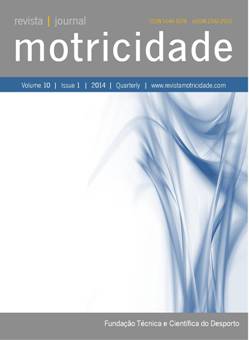A necessidade de parâmetros referenciais de cortisol em atletas: Uma revisão sistemática
DOI:
https://doi.org/10.6063/motricidade.2610Resumo
As concentrações de cortisol constituem uma importante variável de mensuração do estresse, mas existem controvérsias sobre as respostas desse hormônio ao exercício físico, treino e competição. O intuito desta revisão sistemática foi analisar objetivos, metodologias e principais resultados das pesquisas que utilizaram o cortisol como medida de análise do estresse em atletas. Verificou-se a predominância do cortisol salivar (54.6%) em várias modalidades desportivas, a maioria foi realizada com modalidades individuais (72.8%), com atletas do género masculino (59%) e atletas profissionais de alto rendimento (91%). Diversos procedimentos e momentos de coleta foram descritos nos artigos revisados. As alterações nas concentrações de cortisol salivar detetadas nestes estudos demonstraram que grande parte das situações desportivas foram consideradas possíveis fontes de estresse para atletas. O maior aumento nas concentrações de cortisol foi encontrado entre a situação basal e a situação pós-competitiva, bem como entre as coletas realizadas no dia da competição e aquelas mensuradas no mesmo horário em repouso. A partir da análise dos resultados da presente revisão, percebeu-se a necessidade de uma padronização nos métodos de análise do cortisol em atletas, bem como do controle do ritmo circadiano, a fim de encontrar valores referenciais.
Downloads
Publicado
Edição
Secção
Licença
Os autores dos manuscritos submetidos para publicação deverão ceder, a título integral e permanente, os direitos de autor (copyright) à revista Motricidade e às Edições Sílabas Didáticas. A cedência de direitos de autor permite a publicação e divulgação do artigo em formato impresso ou eletrónico e entrará em vigor a partir da data de aceitação do manuscrito. Os autores concedem, ainda, os direitos para a revista Motricidade utilizar e explorar o respetivo artigo, nomeadamente para licenciar, ceder ou vender o seu conteúdo a bases de resumos/indexação ou outras entidades.
Nos termos da licença “Creative Commons”, os autores poderão reproduzir um número razoável de exemplares para uso pessoal ou profissional, mas sem fins comerciais. Nos termos da licença SHERPA/RoMEO, os autores poderão, ainda, disponibilizar/arquivar uma cópia digital final (versão postprint) do artigo no seu website ou no repositório científico da sua instituição.


